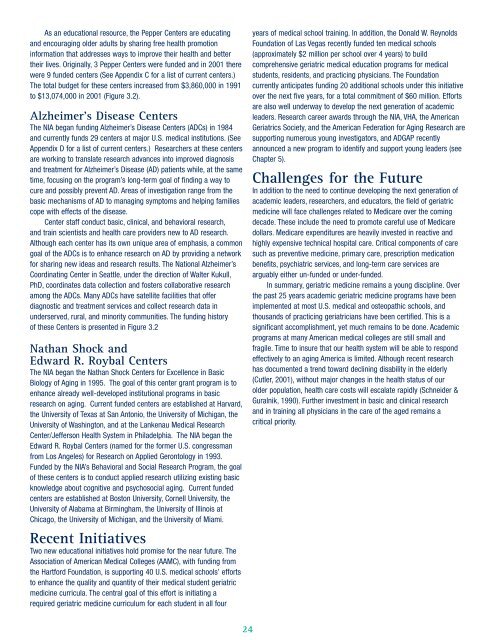Geriatric Medicine Training and Practice in the United States at the ...
Geriatric Medicine Training and Practice in the United States at the ...
Geriatric Medicine Training and Practice in the United States at the ...
You also want an ePaper? Increase the reach of your titles
YUMPU automatically turns print PDFs into web optimized ePapers that Google loves.
As an educ<strong>at</strong>ional resource, <strong>the</strong> Pepper Centers are educ<strong>at</strong><strong>in</strong>g<br />
<strong>and</strong> encourag<strong>in</strong>g older adults by shar<strong>in</strong>g free health promotion<br />
<strong>in</strong>form<strong>at</strong>ion th<strong>at</strong> addresses ways to improve <strong>the</strong>ir health <strong>and</strong> better<br />
<strong>the</strong>ir lives. Orig<strong>in</strong>ally, 3 Pepper Centers were funded <strong>and</strong> <strong>in</strong> 2001 <strong>the</strong>re<br />
were 9 funded centers (See Appendix C for a list of current centers.)<br />
The total budget for <strong>the</strong>se centers <strong>in</strong>creased from $3,860,000 <strong>in</strong> 1991<br />
to $13,074,000 <strong>in</strong> 2001 (Figure 3.2).<br />
Alzheimer’s Disease Centers<br />
The NIA began fund<strong>in</strong>g Alzheimer’s Disease Centers (ADCs) <strong>in</strong> 1984<br />
<strong>and</strong> currently funds 29 centers <strong>at</strong> major U.S. medical <strong>in</strong>stitutions. (See<br />
Appendix D for a list of current centers.) Researchers <strong>at</strong> <strong>the</strong>se centers<br />
are work<strong>in</strong>g to transl<strong>at</strong>e research advances <strong>in</strong>to improved diagnosis<br />
<strong>and</strong> tre<strong>at</strong>ment for Alzheimer’s Disease (AD) p<strong>at</strong>ients while, <strong>at</strong> <strong>the</strong> same<br />
time, focus<strong>in</strong>g on <strong>the</strong> program’s long-term goal of f<strong>in</strong>d<strong>in</strong>g a way to<br />
cure <strong>and</strong> possibly prevent AD. Areas of <strong>in</strong>vestig<strong>at</strong>ion range from <strong>the</strong><br />
basic mechanisms of AD to manag<strong>in</strong>g symptoms <strong>and</strong> help<strong>in</strong>g families<br />
cope with effects of <strong>the</strong> disease.<br />
Center staff conduct basic, cl<strong>in</strong>ical, <strong>and</strong> behavioral research,<br />
<strong>and</strong> tra<strong>in</strong> scientists <strong>and</strong> health care providers new to AD research.<br />
Although each center has its own unique area of emphasis, a common<br />
goal of <strong>the</strong> ADCs is to enhance research on AD by provid<strong>in</strong>g a network<br />
for shar<strong>in</strong>g new ideas <strong>and</strong> research results. The N<strong>at</strong>ional Alzheimer’s<br />
Coord<strong>in</strong><strong>at</strong><strong>in</strong>g Center <strong>in</strong> Se<strong>at</strong>tle, under <strong>the</strong> direction of Walter Kukull,<br />
PhD, coord<strong>in</strong><strong>at</strong>es d<strong>at</strong>a collection <strong>and</strong> fosters collabor<strong>at</strong>ive research<br />
among <strong>the</strong> ADCs. Many ADCs have s<strong>at</strong>ellite facilities th<strong>at</strong> offer<br />
diagnostic <strong>and</strong> tre<strong>at</strong>ment services <strong>and</strong> collect research d<strong>at</strong>a <strong>in</strong><br />
underserved, rural, <strong>and</strong> m<strong>in</strong>ority communities. The fund<strong>in</strong>g history<br />
of <strong>the</strong>se Centers is presented <strong>in</strong> Figure 3.2<br />
N<strong>at</strong>han Shock <strong>and</strong><br />
Edward R. Roybal Centers<br />
The NIA began <strong>the</strong> N<strong>at</strong>han Shock Centers for Excellence <strong>in</strong> Basic<br />
Biology of Ag<strong>in</strong>g <strong>in</strong> 1995. The goal of this center grant program is to<br />
enhance already well-developed <strong>in</strong>stitutional programs <strong>in</strong> basic<br />
research on ag<strong>in</strong>g. Current funded centers are established <strong>at</strong> Harvard,<br />
<strong>the</strong> University of Texas <strong>at</strong> San Antonio, <strong>the</strong> University of Michigan, <strong>the</strong><br />
University of Wash<strong>in</strong>gton, <strong>and</strong> <strong>at</strong> <strong>the</strong> Lankenau Medical Research<br />
Center/Jefferson Health System <strong>in</strong> Philadelphia. The NIA began <strong>the</strong><br />
Edward R. Roybal Centers (named for <strong>the</strong> former U.S. congressman<br />
from Los Angeles) for Research on Applied Gerontology <strong>in</strong> 1993.<br />
Funded by <strong>the</strong> NIA’s Behavioral <strong>and</strong> Social Research Program, <strong>the</strong> goal<br />
of <strong>the</strong>se centers is to conduct applied research utiliz<strong>in</strong>g exist<strong>in</strong>g basic<br />
knowledge about cognitive <strong>and</strong> psychosocial ag<strong>in</strong>g. Current funded<br />
centers are established <strong>at</strong> Boston University, Cornell University, <strong>the</strong><br />
University of Alabama <strong>at</strong> Birm<strong>in</strong>gham, <strong>the</strong> University of Ill<strong>in</strong>ois <strong>at</strong><br />
Chicago, <strong>the</strong> University of Michigan, <strong>and</strong> <strong>the</strong> University of Miami.<br />
Recent Initi<strong>at</strong>ives<br />
Two new educ<strong>at</strong>ional <strong>in</strong>iti<strong>at</strong>ives hold promise for <strong>the</strong> near future. The<br />
Associ<strong>at</strong>ion of American Medical Colleges (AAMC), with fund<strong>in</strong>g from<br />
<strong>the</strong> Hartford Found<strong>at</strong>ion, is support<strong>in</strong>g 40 U.S. medical schools’ efforts<br />
to enhance <strong>the</strong> quality <strong>and</strong> quantity of <strong>the</strong>ir medical student geri<strong>at</strong>ric<br />
medic<strong>in</strong>e curricula. The central goal of this effort is <strong>in</strong>iti<strong>at</strong><strong>in</strong>g a<br />
required geri<strong>at</strong>ric medic<strong>in</strong>e curriculum for each student <strong>in</strong> all four<br />
years of medical school tra<strong>in</strong><strong>in</strong>g. In addition, <strong>the</strong> Donald W. Reynolds<br />
Found<strong>at</strong>ion of Las Vegas recently funded ten medical schools<br />
(approxim<strong>at</strong>ely $2 million per school over 4 years) to build<br />
comprehensive geri<strong>at</strong>ric medical educ<strong>at</strong>ion programs for medical<br />
students, residents, <strong>and</strong> practic<strong>in</strong>g physicians. The Found<strong>at</strong>ion<br />
currently anticip<strong>at</strong>es fund<strong>in</strong>g 20 additional schools under this <strong>in</strong>iti<strong>at</strong>ive<br />
over <strong>the</strong> next five years, for a total commitment of $60 million. Efforts<br />
are also well underway to develop <strong>the</strong> next gener<strong>at</strong>ion of academic<br />
leaders. Research career awards through <strong>the</strong> NIA, VHA, <strong>the</strong> American<br />
<strong>Geri<strong>at</strong>ric</strong>s Society, <strong>and</strong> <strong>the</strong> American Feder<strong>at</strong>ion for Ag<strong>in</strong>g Research are<br />
support<strong>in</strong>g numerous young <strong>in</strong>vestig<strong>at</strong>ors, <strong>and</strong> ADGAP recently<br />
announced a new program to identify <strong>and</strong> support young leaders (see<br />
Chapter 5).<br />
Challenges for <strong>the</strong> Future<br />
In addition to <strong>the</strong> need to cont<strong>in</strong>ue develop<strong>in</strong>g <strong>the</strong> next gener<strong>at</strong>ion of<br />
academic leaders, researchers, <strong>and</strong> educ<strong>at</strong>ors, <strong>the</strong> field of geri<strong>at</strong>ric<br />
medic<strong>in</strong>e will face challenges rel<strong>at</strong>ed to Medicare over <strong>the</strong> com<strong>in</strong>g<br />
decade. These <strong>in</strong>clude <strong>the</strong> need to promote careful use of Medicare<br />
dollars. Medicare expenditures are heavily <strong>in</strong>vested <strong>in</strong> reactive <strong>and</strong><br />
highly expensive technical hospital care. Critical components of care<br />
such as preventive medic<strong>in</strong>e, primary care, prescription medic<strong>at</strong>ion<br />
benefits, psychi<strong>at</strong>ric services, <strong>and</strong> long-term care services are<br />
arguably ei<strong>the</strong>r un-funded or under-funded.<br />
In summary, geri<strong>at</strong>ric medic<strong>in</strong>e rema<strong>in</strong>s a young discipl<strong>in</strong>e. Over<br />
<strong>the</strong> past 25 years academic geri<strong>at</strong>ric medic<strong>in</strong>e programs have been<br />
implemented <strong>at</strong> most U.S. medical <strong>and</strong> osteop<strong>at</strong>hic schools, <strong>and</strong><br />
thous<strong>and</strong>s of practic<strong>in</strong>g geri<strong>at</strong>ricians have been certified. This is a<br />
significant accomplishment, yet much rema<strong>in</strong>s to be done. Academic<br />
programs <strong>at</strong> many American medical colleges are still small <strong>and</strong><br />
fragile. Time to <strong>in</strong>sure th<strong>at</strong> our health system will be able to respond<br />
effectively to an ag<strong>in</strong>g America is limited. Although recent research<br />
has documented a trend toward decl<strong>in</strong><strong>in</strong>g disability <strong>in</strong> <strong>the</strong> elderly<br />
(Cutler, 2001), without major changes <strong>in</strong> <strong>the</strong> health st<strong>at</strong>us of our<br />
older popul<strong>at</strong>ion, health care costs will escal<strong>at</strong>e rapidly (Schneider &<br />
Guralnik, 1990). Fur<strong>the</strong>r <strong>in</strong>vestment <strong>in</strong> basic <strong>and</strong> cl<strong>in</strong>ical research<br />
<strong>and</strong> <strong>in</strong> tra<strong>in</strong><strong>in</strong>g all physicians <strong>in</strong> <strong>the</strong> care of <strong>the</strong> aged rema<strong>in</strong>s a<br />
critical priority.<br />
24

















